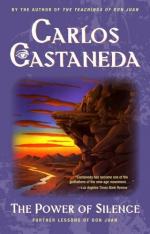|
This section contains 428 words (approx. 2 pages at 400 words per page) |

|
The Power of Silence: Further Lessons of Don Juan Summary & Study Guide Description
The Power of Silence: Further Lessons of Don Juan Summary & Study Guide includes comprehensive information and analysis to help you understand the book. This study guide contains the following sections:
This detailed literature summary also contains Topics for Discussion and a Free Quiz on The Power of Silence: Further Lessons of Don Juan by Carlos Castaneda.
THE POWER OF SILENCE is anthropologist Carlos Casteneda's account of the teachings and methods of a Mexican Indian sorcerer, don Juan Matus, taught him. This book is one of many that record the on-going process of becoming a sorcerer, including Carlos's path to sorcery. Carlos notes that to deal intelligently with everyday life we need to train for years. The knowledge we need is complicated. The same, he says, is true of the sorcerer's world - it requires great schooling through oral instruction, manipulation of awareness, and so on.
Don Juan describes himself as a nagual, his name for a sorcerer. The nagual worldview holds that the world is contained of great bans of energy that emanate from a kind of world spirit. It manifests itself in a force known as intent. The center of energy in the universe is a God-like power known as the Eagle. Humans are simply concentrations of energy and power, places where energy bands intersect. The center point of their energy bands is called "the assemblage point." The assemblage point dictates the state of awareness that each person is in. Most of the time their assemblage point remains unmoved and stuck in a state of awareness focused only on the concrete and practical, the mundane. The job of sorcery is to teach each person who wants to, to move their own assemblage points at will to achieve liberation from the ordinary ways of life in order to know the spirit and intent and the abstract. Humanity, from the sorcerers' view, has undergone a kind of corruption, which has moved each person's assemblage point to a place of self-focus, self-pity and self-reflection, and only the actions of the spirit through the practice of sorcery can reestablish one's connection with intent.
Sorcery consists of three areas of expertise: the mastery of awareness, the art of stalking and the mastery of intent. The knowledge of these fields of expertise and the path to total, free awareness of the universe, is contained in three sets of six abstract cores. This book is the book of the first set, which contains the following abstract cores: the manifestations of the spirit, the knock of the spirit, the trickery of the spirit, the descent of the spirit, the requirements of intent, and handling intent. Each of these abstract cores forms a chapter of the book and is communicated through interactions between Carlos and don Juan and stories that don Juan recounts of his interactions with his teachers, the nagual Julian, and his teacher, the nagual Elias.
Read more from the Study Guide
|
This section contains 428 words (approx. 2 pages at 400 words per page) |

|



